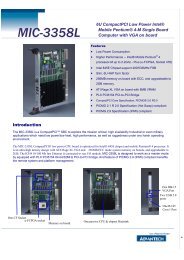industrial wireless book special edition - Networking ...
industrial wireless book special edition - Networking ...
industrial wireless book special edition - Networking ...
You also want an ePaper? Increase the reach of your titles
YUMPU automatically turns print PDFs into web optimized ePapers that Google loves.
<strong>industrial</strong> <strong>wireless</strong><br />
IEEE WLAN standard Over the air estimates Media Access Control layer,<br />
service access point estimates<br />
IEEE802.11b 11 Mbps 5Mbps<br />
IEEE802.11g 54 Mbps 25 Mbps (when 11b not present)<br />
IEEE802.11a 54Mbps 25 Mbps<br />
IEEE802.11n 300 Mbps 150 Mbps<br />
Comparison of different 802.11 transfer rates (source: Intel Labs)<br />
Versions /g and /b operate at 2.4GHz while<br />
/a operates at 5GHz. The advantage of 802.11n<br />
is that it can operate at both frequencies, being<br />
able to support simultaneous 802.11a and<br />
802.11n links at 5GHz, or 802.11b, /g and /n<br />
links at 2.4GHz. Where backwards compatibility<br />
is not an issue, 802.11n hardware can be<br />
configured to run <strong>special</strong> features. To improve<br />
<strong>wireless</strong> network range, throughput and reliability,<br />
802.11n has three properties over and<br />
above older standards: MIMO, packet aggregation<br />
and channel bonding. Taken together,<br />
these offer a fivefold increase in performance<br />
over 802.11a/b/g networks.<br />
MIMO (multiple in, multiple out) systems are<br />
built using multiple vector antennas at both<br />
the transmitter and the receiver, thus providing<br />
a mimo system with its desirable qualities.<br />
Since it can employ both diversity and multiplexing<br />
of simultaneous data streams, it<br />
potentially increases system capacity by three<br />
or more times. Depending on where mimo<br />
signals are processed, a mimo system can be<br />
classified into three distinct types: receiver<br />
processing only, transmitter processing only,<br />
both TX and RX processing systems.<br />
Receiver processing only. Receivers employ<br />
multiple front ends rather than mimo signal<br />
processing. Antennas at the receiver are<br />
connected to multiple independent front ends<br />
producing separate data streams. These streams<br />
are then multiplexed (muxed) into a single data<br />
stream providing a much higher data rate than<br />
a single antenna system.<br />
Transmitter processing only. In this reverse<br />
scenario a single data stream is demuxed and<br />
transmitted as multiple substreams. When the<br />
p pp g g g g<br />
signals from different antennas arrive at the<br />
receiver, mimo signal processing must be<br />
performed using one of three schemes: spacetime<br />
coding, vertical Bell Lab Layered<br />
Space-Time (V-Blast), and maximum likelihood<br />
detection (MLD). MLD provides the best performance<br />
of the three.<br />
Transmitter and Receiver Processing. Perhaps<br />
the best of both worlds, but with better performance?<br />
Well partly, but it comes at a price as<br />
the hardware is both complicated to configure<br />
and administer. The most popular method of<br />
performing the two functions is known as<br />
singular value decomposition which diagonalizes<br />
the mimo channels to form independent<br />
channels, to which water filling – data-packing<br />
– schemes can be applied to maximise overall<br />
system capacity. With enough processing power<br />
available within the mesh routers all types of<br />
mimo systems can be applied. However, for<br />
ease, transmitter-processing-only mimo is<br />
applied from mesh routers to mesh clients and<br />
receiver-processing-only mimo for links from<br />
the routers to the clients.<br />
Packet aggregation<br />
Packet aggregation increases efficiency by<br />
aggregating multiple packets of an application<br />
into a single transmission frame, and so<br />
enabling them to be sent with a fixed overhead<br />
cost of just a single frame. Packet aggregation<br />
works best for data applications such as file<br />
transfers. For real-time applications such as<br />
voice or video transmission, packet aggregation<br />
has no effect and it is better to minimise<br />
the number of ‘packed’ packets to reduce<br />
latency and eliminate jitter contention.<br />
Channel bonding<br />
Where 802.11a/g only supports 20MHz<br />
spectrum width to carry a maximum of 54Mbps<br />
of raw data per channel, 802.11n increases that<br />
to 150Mbps per channel. A technique called<br />
channel bonding combines two adjacent 20MHz<br />
channels into a single 40MHz channel, thereby<br />
doubling the throughput to over 300Mbps.<br />
Channel bonding works best at 5GHz because<br />
there are over 100 channels in the spectrum<br />
block, whereas at 2.4GHz only three non-overlapping<br />
20MHz are available for use.<br />
Fast roaming<br />
A Mesh solution would comprise one mesh<br />
gateway (one way connected with switch by<br />
Ethernet cable and one way connected with<br />
mesh node or mesh AP via radio), a number of<br />
entirely <strong>wireless</strong>-connected mesh nodes (which<br />
of course connect with the mesh gateway via<br />
radio and and all the others in the mesh). These<br />
in turn hop on to mesh APs (and other mesh<br />
nodes), hooking one-to-one with other WLAN<br />
mesh stations or regular Wi-Fi clients. The mesh<br />
nodes are dependent upon the throughput<br />
requirements.<br />
Fast roaming is a <strong>special</strong> feature of a mesh<br />
station – it is not a regular Wi-Fi client – and<br />
the handover time between two mesh APs can<br />
be as fast as 20ms. They achieve this in the<br />
following way. The Mesh APs are set to periodically<br />
and proactively broadcast information<br />
to nearby mesh stations. The mesh stations<br />
which are under the coverage of mesh APs can<br />
periodically generate a list of path scores. Once<br />
a new path score is generated and shown to<br />
be better than the current link score, the mesh<br />
station will handover the path to another mesh<br />
AP without further authentication and association<br />
processes. These two steps were<br />
performed when the mesh station first joined<br />
the mesh network.<br />
This sort of <strong>wireless</strong> mesh system using an<br />
ultra-fast roaming algorithm is suited to<br />
handling communication between fast-moving<br />
trains and the trackside. By installing an EKI-<br />
6351 mesh station inside a train and an<br />
EKI-6340 access point along the side of the<br />
rail, communication can be maintained without<br />
connection loss since the short handover time<br />
permits this. Even in an environment where<br />
fibre links to the AP cannot be installed, the<br />
hardware of this example has three radios, so<br />
establishing a <strong>wireless</strong> backbone through its<br />
two spare radios.<br />
Alex Tsai is Industrial Communication Product<br />
Development Manager for Advantech's Industrial<br />
Automation Group.<br />
6<br />
Fast enough for express handover: This sort of <strong>wireless</strong> mesh system using an ultra-fast roaming algorithm is suited to<br />
handling communication between fast-moving trains and the trackside.<br />
<strong>industrial</strong> ethernet <strong>book</strong><br />
Kunhong Chen is Industrial Communication Product<br />
Manager for Advantech Industrial Automation Group. He<br />
has 10 years working experience with Industrial Wireless<br />
and device server technology for Intel, Gemtek and now<br />
Advantech.<br />
sponsored by Advantech

















